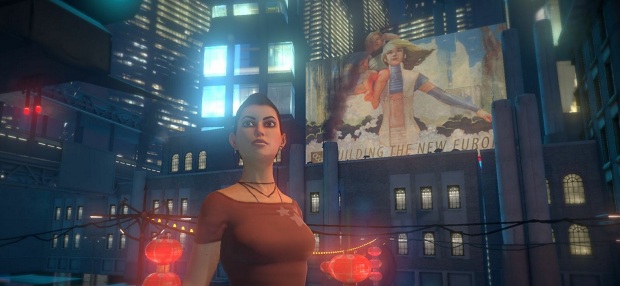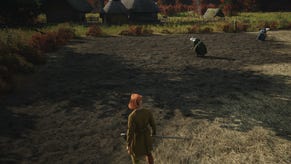Hands On: Dreamfall Chapters
Journey's End
Dreamfall Chapters opens with a series of nightmares, wasting no time before informing the player of the high stakes and gravity of its multi-threaded plot. It’s a personal story, of family and sacrifice, but the potential consequences are cosmic. In truth, it’s not a single story at all, it’s a collection of stories within stories and about stories, taking the disparate worlds of The Longest Journey and weaving a larger tapestry. I’ve played the first three hours and found something quite different to the point and click adventure I was expecting.
Dreamfall Chapters isn’t a traditional adventure game. Tørnquist and his new independent studio, Red Thread Games, contains several ex-Funcom members, but they're looking to the future rather than the past. A key goal, for this and future games, is to explore ways to build an interactive experience in which the process of playing is structured around narrative and characters rather than puzzles and roadblocks. In Chapters, occasional hurdles require intellectual prodding but, based on conversations with the team and the time spent with the game, the main challenge is to integrate emotional responses into an interactive narrative.
Flying in the face of my expectations, Dreamfall Chapters is a Kickstarted continuation of a story from gaming’s past that isn’t content to tickle the nostalgia glands of its ready-made audience. Red Thread want to tell their story and to fill in the strands of the web but in doing so they’re asking questions about the nature of narrative games. A key issue is to find ways to involve players in ways that wouldn’t be feasible if they were watching a video playthrough. Another key issue is to avoid the obvious solution that was the stealth and combat of the previous Dreamfall – the player’s interactions with the game must fit with the theme and story. And they should, above all, be enjoyable.
One of Zoe’s early lines taps on the fourth wall. I paraphrase: “I remember climbing around, sneaking, fighting – things I'm not supposed to be doing.” When I ask Tørnquist if this is a deliberately sly reference, and a self-deprecating one at that, he laughs. Of course it is. There’s precious little to laugh at in the grand narrative sweep of the Dreamfall saga, which can make it easy to forget the humour in the scripts. The characters, not the situations, are the basis of that humour and from the earliest scenes in The Longest Journey’s Border House there has been as much (if not more) time and effort placed on building the finer details of those characters than on the grander scope of the mythology.
It’s a relief, then, to see that the Serious Business that reintroduces players to the series’ worlds within worlds falls away, making room for the poignancy of the personal. Dreamfall's Zoe is the focus, eking out an existence in the future noir of Europolis, a continent become a city that is on the verge of political upheaval. Elections are approaching and Zoe splits her time between therapy, campaigning for a new leader and a better future, and working in a machine shop with a foul-mouthed short-tempered boss and her mute colleague, Wit, who is a gentle giant with intimidating body modifications.
There's a boyfriend too, whose journalistic work provides an alternate view of the political situation. The game's opening lays out Zoe's almost mythical status and ties it to the sci-fi tech of Europolis, but in a pleasing echo of The Longest Journey, a return to normalcy follows. Fantastical worlds exist and Zoe has a terrifying destiny to fulfil, but there's plenty of time to rediscover the magic of the mundane.
I mined the Europolis hub for every line of dialogue, colouring in the corners of the world and spending as much time as possible with its characters. Tørnquist tells me that he wants to warn people that there are meaty great conversations throughout Dreamfall Chapters – “it's a game where almost everybody has a lot to say” - and even in their unfinished state, the three major sections that I played are dense. It'd certainly be possible to hit all the key conversation points and rush forward, but it'd be like skimming through a novel, reading every other page, or wandering through an art gallery while browsing the web on your phone.
The world has been designed to encourage exploration, through observation as well as conversation, and the writing is strong enough to reward the curious. Zoe has undergone something of a personality transplant and is pleasant to spend time with, while having just enough gaps in her motivations and opinions for the player to insert little pieces of themselves. Like a Telltale protagonist, Zoe is malleable, as is her story.
With the concept of destiny so central to the plot, it'd be strange if the fate of worlds could be tipped by the player's choices, but seemingly minor decisions early in the game may have repercussions throughout. While all roads leave to the same final destination, there are many variations on the final scenes, depending who has survived the journey and how the relationships between characters have developed.
The shadow of The Walking Dead looms large. Tørnquist tells me that Chapters is “far closer to a Telltale game than it is to The Longest Journey”. Indeed, while I'm told that the puzzles become more complex as the story progresses, the first areas only require a minimum of 'adventure game logic'. At one point, a bug in the build I was playing meant that I was left without a vital inventory item. Not realising that anything had gone wrong, I tried to find a solution by rummaging through memories of the previous games. I fully expected a convoluted mix of backtracking, abstract item combinations and inflatable ducks.
Not the case. As soon as the problem was fixed – in a matter of seconds once someone became aware of my plight – the solution was obvious and, despite requiring an item, based in dialogue. There are a few inventory-based puzzles in the portion I played but every object has a credible reason to exist in the place where it Is found and seemingly incidental lines of speech provide clues to those paying attention.
Conversation choices usually involve clicking through a list of keywords, one by one, but occasionally a decision must be made. Tørnquist is adamant that these decisions are not moral choices, pointing to the extremes of Bioware's light and dark scales as something he wants to avoid. Instead, the choice is often between a rock and a hard place, or a selection from a takeaway lunch menu. When selecting a response, hovering over each option plays out the player character's inner monologue, so there are no nasty surprises a la LA Noire, when a prompt to suggest someone might be lying sometimes lead to a pop-eyed stream of expletives.
Being able to hear the character's reasoning behind every possibility before picking doesn't just give the player more control, it also provides an emotional and psychological consistency. Characters provide credible reasons as to why they might act a certain way rather than flipping between good cop and bad cop from one moment to the next. Thinking through possibilities alongside the player characters gives a stronger sense of attachment, creating a sense of responsibility. ‘Guilt’ is a word that came up during conversation about the decisions that come later in the game.
While Dreamfall Chapters does overlap with Telltale’s recent games, it differs in one key area. The district of Europolis that I’ve seen is open for exploration. It isn’t particularly large - which cuts down on backtracking and the sort of scenery-scanning what would be a new form of pixel hunting – but there’s plenty to look at. I played with mouse and keyboard, though controllers are supported as well, and the control scheme seems sensible. Standard third-person movement with the WASD keys and hotspot-clicking with the mouse. Moving close to an interactive element causes a highlight to appear, so there’s no need to scour the screen.
There’s still plenty to see though. Posters, shop signs and even the clothes that people wear tell their own stories. Europolis is richly textured and every logo and campaign slogan contains a little piece of background information. It’s here that the details of the design process can be seen most clearly. Unlike Telltale’s games or even The Longest Journey, Chapters allows players to set their own pace. That, I believe, is why the more esoteric puzzles have been pushed aside – they act like a stop sign, killing momentum. Equally, the game rarely takes away control, as occurs in The Walking Dead and Wolfamongous, instead allowing players to investigate the quieter corners of the world at their own leisure.
I learned that Ireland has become a feral state, with limited technology and a single daily ferry from Liverpool as its only contact with the outside world. Also that Africa is a first-world paradise in comparison to the slums of Europolis. I picked up some future slang and discovered that corporations are creating hallucinogenic Cola to force brand mascot imagery into peoples’ minds. None of that, as far as I know, will be essential to the plot but it adds to the credibility of the world, and like the Coens, Red Thread do great minor characters.
There’s always the possibility that the story will become less attractive when it moves back toward the magic and mythology. I tend to prefer the small details and my favourite memories of the series are in the quiet moments, when April and Zoe confront recognisable problems in the midst of fantastical scenarios. There’s plenty of that in the opening hours and the delivery, with the hub and conversation systems, is intelligent. It's also surprisingly emotional, even in these opening scenes (I almost needed to borrow John's 'No Tears' shampoo despite being in an office surrounded by programmers), and a large part of that is due to the excellent score.
As someone who wants to see the end of the story, I’m relieved to see that the budget and talent seem equal to the task. But playing with the early build and talking to the creators was satisfying in other ways. There’s an ambition about Chapters that I hadn’t expected, a desire not just to tie up loose ends in a familiar fashion but to find out what a narrative interactive adventure can be if some lessons are forgotten and some new ones are constructed along the way.
Disclaimer - John has this to say. Nothing I've seen has his grubby fingerprints on it. More on Red Thread and Dreamfall Chapters later this week, along with a closer look at horror-mystery Draugen.















